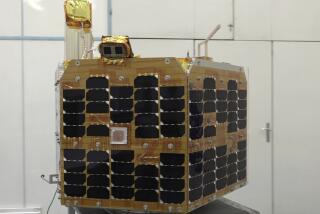‘Very Successful’ Atlas Launch Puts Satellite in Orbit
- Share via
KENNEDY SPACE CENTER, Fla. — A powerful rocket propelled a $125-million military communications satellite into orbit Thursday night as NASA chalked up a fourth straight U.S. space launch success and continued its rebound from a disastrous 1986 start.
The 137-foot-tall Atlas-Centaur rocket blasted away from its launch pad at 6:30 p.m. and carved a fiery path as it hoisted a payload designed to link land, sea and air forces with the Joint Chiefs of Staff, the National Command Authority and the President.
Twenty-eight minutes later, NASA launch commentator George Diller reported the two-stage booster had done its job and hurled the satellite into a temporary elliptical orbit ranging from about 103 to 22,330 miles high.
“All mission elements have been accomplished; we’ve had a very successful mission,” Diller said. He reported good data was being received from the satellite.
An on-board motor is scheduled to fire Saturday night to put the spacecraft in stationary orbit 22,300 miles above the Equator.
Liftoff came 26 minutes late because of a minor radio telemetry problem in the satellite, Diller said.
The successful launch continued a modest string of successes that began in September with the launch of a Delta rocket carrying a payload for the Reagan Administration’s Strategic Defense Initiative program, popularly known as “Star Wars.”
Since then, an Atlas launched a weather satellite and a Scout booster orbited a science payload.
Those flights followed a nightmarish 1986 start for the U.S. space program. The space shuttle Challenger exploded on Jan. 28, killing seven crew members; an Air Force Titan 34D exploded on April 18 as it boosted a reconnaissance satellite, and a Delta failed on May 3 with a weather satellite aboard.
Before those failures, space shuttles had logged 24 straight successes and the Delta and Titan rockets had recorded success rates of better than 90%, including 43 in a row for the Delta.
The accidents grounded U.S. unmanned space rockets for several months. The shuttle will not fly again until at least February, 1988.
The launch Thursday night was the National Aeronautic and Space Administration’s last one scheduled in 1986.
The Atlas-Centaur payload is the sixth in a series of Fleet Satellite Communications satellites developed by the Navy and TRW Inc. The satellites relay ultra-high frequency communications over 23 channels to military commands around the world.
The launching previously had been delayed eight times in seven months. It originally was scheduled last May 22, but after the May 3 Delta failure it was postponed because of similarities between the Delta and Atlas guidance systems. A faulty guidance package was blamed for the Delta failure.
That problem was resolved, but a series of other technical problems forced other delays.
NASA conceded that it is being exceedingly cautious because of the earlier failures.
Asked if a continued success streak would make NASA less cautious, John W. Gibb, manager of the Atlas-Centaur project office at the Lewis Research Center in Cleveland, replied: “No, that time of extra caution is not over. . . . I think we’ll always be sensitive to the events of the first of the year.
More to Read
Sign up for Essential California
The most important California stories and recommendations in your inbox every morning.
You may occasionally receive promotional content from the Los Angeles Times.













